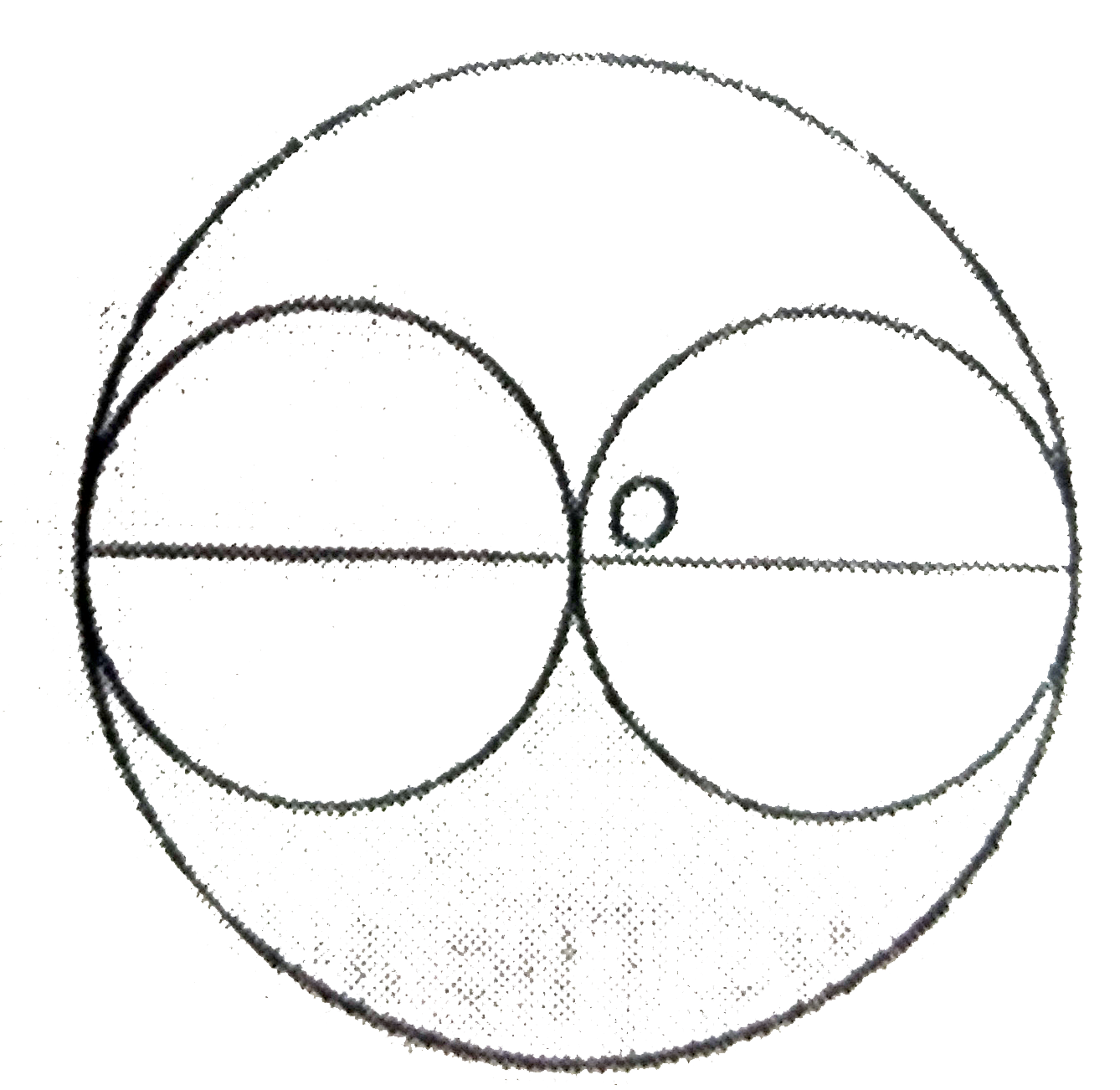If inside a big circle exactly n(n≤3) small circles, each of radius r, can be drawn in such a way that each small circle touches the big circle and also touches both its adjacent small circles, then the radius of big circle is r(1+cosecπn) (b) (1+tanπncosππ) r[1+cosec2πn] (d) r[s∈π2n+cos(2π)n]2sinπnSolution in Bengali
r(1+cosec.πn)
(1+tanπ/ncosπ/n)
r[1+cosec.2πn]
r[sin.π2n+cos.2πn]2sinπ/n
The correct Answer is:A, D

If R is radius of bigger circle, then sin(πn)=rR−r
or R=r(1+cosec(πn))=r[sinπ2n+cosπ2n]2sinπn
Topper's Solved these Questions
- BOOK - CENGAGE PUBLICATIONCHAPTER - PROPERTIES AND SOLUTIONS OF TRIANGLEEXERCISE - Linked comprehension type34videos
PROPERTIES AND SOLUTIONS OF TRIANGLE
- BOOK - CENGAGE PUBLICATIONCHAPTER - PROPERTIES AND SOLUTIONS OF TRIANGLEEXERCISE - Matrix match type6videos
PROPERTIES AND SOLUTIONS OF TRIANGLE
- BOOK - CENGAGE PUBLICATIONCHAPTER - PROPERTIES AND SOLUTIONS OF TRIANGLEEXERCISE - Exercises80videos
PROPERTIES AND SOLUTIONS OF TRIANGLE
- BOOK - CENGAGE PUBLICATIONCHAPTER - PROGRESSION AND SERIESEXERCISE - ARCHIVES (NUMERICAL VALUE TYPE )8videos
PROGRESSION AND SERIES
- BOOK - CENGAGE PUBLICATIONCHAPTER - RELATIONS AND FUNCTIONSEXERCISE - All Questions1119videos
RELATIONS AND FUNCTIONS
Similar Questions
Given that Δ=6,r1=2,r2=3,r3=6
Circumradius R is equal to a) 2.5 b)3.5 c)1.5 d)none of these05:05View Solutionshow that tan−1(12)+tan−1(211)=tan−1(34)
05:05View SolutionIn ΔABC,sinA(a−bcosC)sinC(c−bcosA)=
10:40View SolutionLet Sk,k=1,2,….100 denote the sum of the infinite geometric series whose first term is k−1K! and the common
ration is 1k then the value of (100)2100!+Σ100k=1|(k^2-3k+1)S_k| is ____________02:56View SolutionIf the function f:[1,∞)→[1,∞) is defined by f(x)=2x(x−1), then find f−1(x)
05:56View SolutionA circle of radius R touches externally a set of 12 circles each of radius r surrounding it.Each one of the smaller circles touches two circles of the set,then ((R)/(r))=sqrt(m)+sqrt(n)-1 where m,n in N and m+n is
13:12View SolutionA circle of radius R touches externally a set of 12 circles each of radus r surronding it. Each one of the smaller circles touches two circles of the set.Then (R)/(r)=sqrt(m)+sqrt(n)-1 where m,n in N and m+n is
02:00View SolutionTwo circles of radius 1 and 4 touch each other externally.Another circle of radius r touches both circles externally and also one direct common tangent of the two circles.Then [(1)/(r)]=
02:45View SolutionIf inside a big circle exactly n(n≤3) small circles, each of radius r, can be drawn in such a way that each small circle touches the big circle and also touches both its adjacent small circles, then the radius of big circle is r(1+cosecπn) (b) (1+tanπncosππ) r[1+cosec2πn] (d) r[s∈π2n+cos(2π)n]2sinπn
View SolutionA circle of radius R touches externally a set of 12 circles each of radius r surrounding it.Each one of the smaller circles touches two circles of the set.Then (R)/(r)=sqrt(m)+sqrt(n)-1, where m,n in N and m+n is
04:08View SolutionCircles of radii 2,2,1 touch each other externally.If a circle of radius r touches all the three circles externally,then r is
05:03View SolutionIf a circle touching all the n sides of a polygon of perimeter 2p has radius r , then the area of the poly-gon is (p−n)r (b) pr (c) (2p−n)r (d) (p+n)r
05:35View SolutionIn the given figure two small circles touch each other externally at the centre of a big circle and these small circles are touched internally by a big circle of radius 74cm. Find the area of the shaded region
 05:03View Solution
05:03View SolutionCircles are inscribed in the acute angle α so that every neighbouring circles touch each other. If the radius of the first circle is R then find the sum of the radii of the first n circles in terms of R and α.
08:30View SolutionBy finding the area of a regular polygon of n sides inscribed in a circle of radius r ,show that the area of the circle is πr2
03:20View SolutionIf inside a big circle exactly n(n≤3) small circles, each of radius r, can be drawn in such a way that each small circle touches the big circle and also touches both its adjacent small circles, then the radius of big circle is r(1+cosecπn) (b) (1+tanπncosππ) r[1+cosec2πn] (d) r[s∈π2n+cos(2π)n]2sinπn
03:58View Solution

